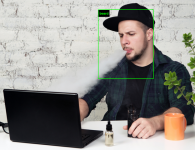

On Instagram, manufacturing fake followers is a ubiquitous tactic, one that’s churned out at least 95 million near-perfect human forgeries for you to brush past in the digital hallways, unaware. You can buy them in droves from dozens of services online, or even from a coin-operated vending machine created by artist Dries Depoorter. He calls his fame dispenser “Quick Fix“: a wall-mounted box with an Arduino and a keyboard, where visitors can type in their social media handles and select what faux-honorific they’d like to receive—likes or follows, starting at just one euro, delivered instantly. In Helsinki, where the machine debuted, “Quick Fix” was a revelation. “Even the young people didn’t know this was possible, but they wanted it,” Depoorter says. “In a city, I think it would fit really well next to a soda machine.”
The fake followers would fit in anywhere: padding out an obscure microinfluencer’s ranks, creating the illusion of customers for would-be T-shirt seller, skulking among legions of real fans on celebrity accounts like Ellen DeGeneres’. A report by cybersecurity firm Cheq projects that these fake fans will cost brands $1.3 billion in 2019 alone. In the influencer economy, you’re paid in part for the size of your audience, which means that, if an influencer’s account is swarming with fake followers, brands are paying extra to reach people who don’t exist.
Agencies and would-be sponsors know they’re being scammed, and are growing more vigilant. “In the last few years, we’ve started holding influencers accountable in their contracts,” says Gabrielle Vogt, senior manager of digital talent at influencer marketing agency HelloSociety. “They have to agree that they haven’t participated in comment pods, botting, or purchasing fake followers.” Let’s break down these forms of fakery. “Comment pods” (or “engagement pods”) are groups of influencers who agree to like and comment on each other’s posts to artificially drive up engagement and improve their algorithmic performance. “Botting” is using automated fake accounts—bots—to bolster an audience, à la the Kremlin-linked Internet Research Agency. In their contemporary form, “fake followers” are often real people, just not always the person they say they are, and, of course, not someone who is an actual fan (and hence, potential customer).
Not being rubes, influencer economy participants know that signing a contract isn’t enough to certify continuous truthfulness. That’s why HelloSociety and most other influencer marketing businesses rely on online tools to sniff out counterfeit or fraudulent accounts—and influencers who profit from them. All of these tools (and there are many, with names like Social Audit Pro, IG Audit, Hypr, HypeAuditor, and Famoid) work a little differently, but they’re all looking for deviations from the platform’s norm. An account with no profile picture, say, or one that follows 10,000 people and never posts. Also suspicious: lots of digits in the username; or a person who seems to live in Turkey or Indonesia, but follows only California-based influencers.
Online tricks evolve like Pokémon, though, and fake followers are getting much harder to identify. The best way to spot fakes now seems to be taking note of the rate at which an influencer acquires followers. “A year ago, I would see influencers buy one to ten thousand followers at a time, and it would show up on a graph as a giant jump out of nowhere,” says Andrew Hogue, creator of IG Audit, an analytical tool he describes as “Carfax for influencers.” (Vogt notes that those jumps can happen naturally, like after a Today show appearance, so HelloSociety always checks the graph against an influencer’s post history.) Lately, sellers have been offering “drip followers”: If an influencer orders 30,000 followers, for example, they arrive only 50 at a time, every day, for 600 days. According to Hogue, detecting drip followers requires a closer inspection of those follower account graphs. “Normal users will have a smooth logarithmic slope,” he says. “If you’ll see a jagged, stair-like pattern out of nowhere, that’s fraud.”
The need for vetting is so strong that the demand caught the makers of several tools by surprise. “I’ve never paid a cent for marketing,” says Robert Harris, creator of Social Audit Pro, a service that analyses the quality and activity of online followings. “It went viral on its own.” When Hogue debuted IG Audit, he saw it go viral in Poland overnight before catching on in the United States, where its virality continues. Last month, the Institute of Contemporary Music Performance ran 100 of the most successful Instagram accounts through IG Audit, reporting that up to half of all the people following celebrities like Ellen DeGeneres, Korean boy band BTS, Kourtney Kardashian, soccer player Neymar, Ariana Grande, and Taylor Swift weren’t real followers at all. The list was written up as news in at least 10 publications.
read more at https://www.wired.com/latest by Emma Grey Ellis
Tech









